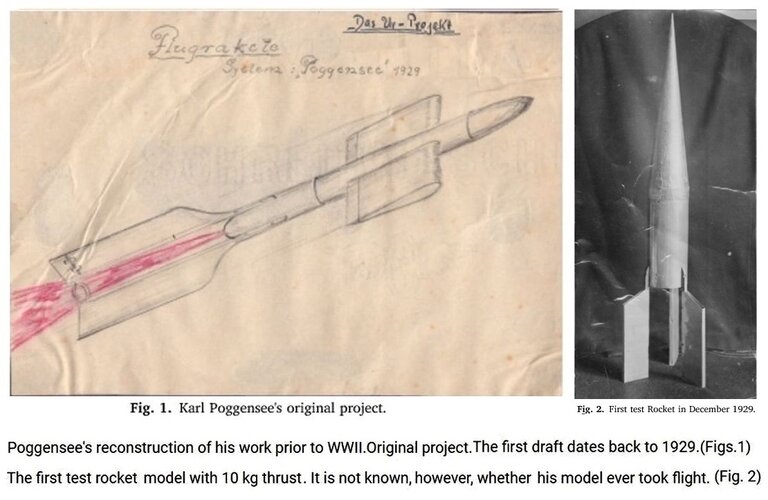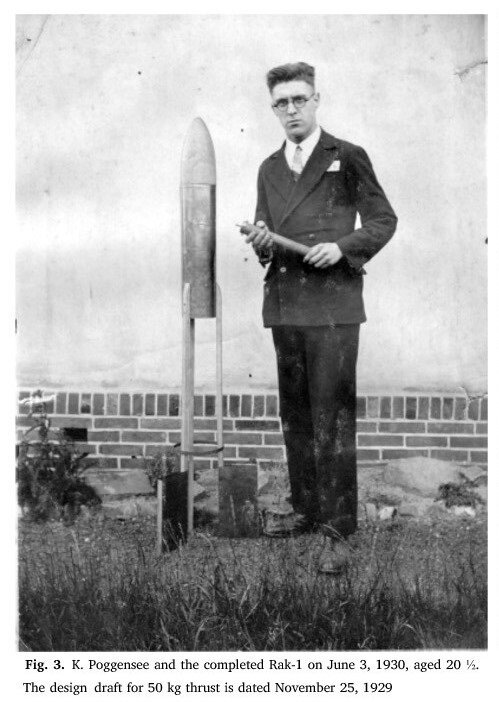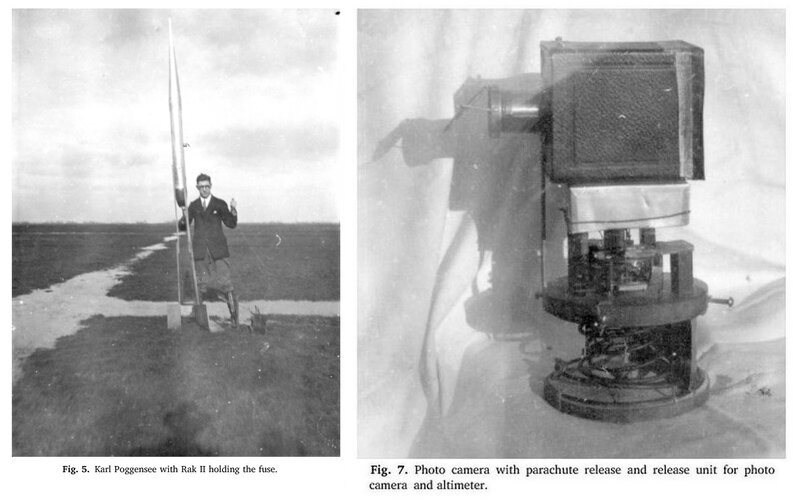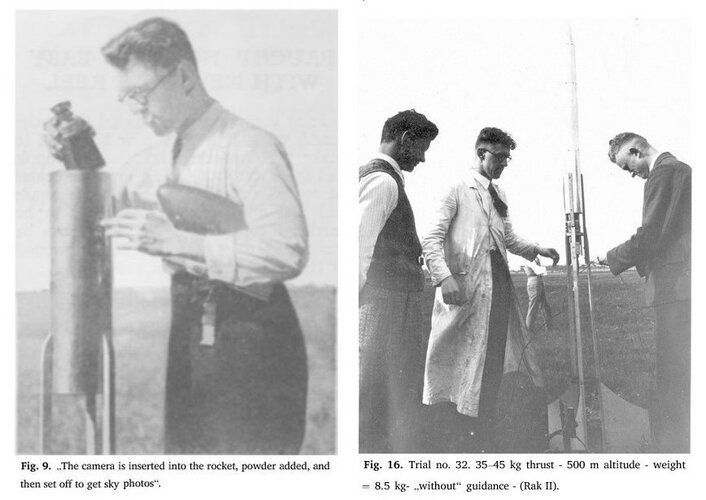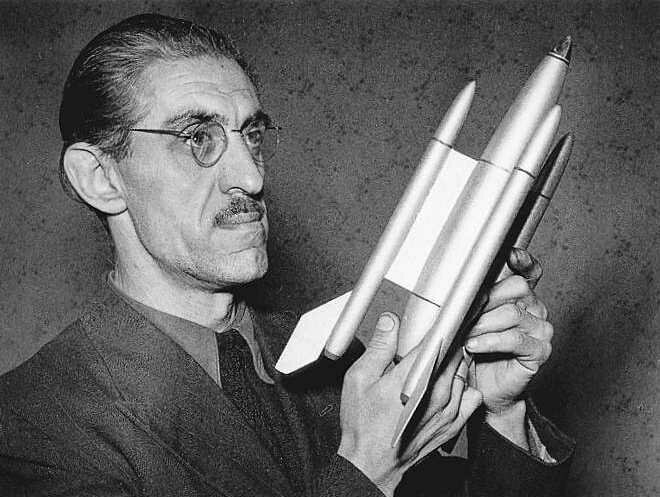klem
I really should change my personal text
- Joined
- 7 March 2015
- Messages
- 726
- Reaction score
- 1,633
The Hermann Oberth Raumfahrt Museum has acquired a file of documents containing photographs, newspaper clippings and comments from Karl Otto Engelbert Poggensee (born December 3, 1903 in Bremen) student of Hinderburg-Polytechnikum, Oldenburg, covering the essays that it carried out between 1930 and 1934. The remaining documents, relating to the period from 1950 to 1970, provide a relatively full account of those years.Karlheinz Rohrwild of the "Hermann-Oberth-Ratumfahrt-Museum" has written an article entitled "Karl Poggensee - A widely unknown German rocket pioneer The early years 1930-1934 - A chronology."
Poggensee started his research into rocketry for spaceflight the end of November 1929, then he joined the "Verein für Raumschifffahrt" e.V. Berlin (Association for spaceflight) among Hermann Oberth, Rudolf Nebel, Wernher von Braun, Max Valier, Johannes Winkler, Franz v. Hoefft.
He build his first solid-fuel rocket, producing his own propellant charges. Being a coming electrical engineer his main goal was to provide his rockets with automatic measuring instruments, camera and parachute release systems.
Poggensee launched a powder rocket at a field near Berlin. the rocket was instrumented with a barometer, a camera, and a velocity measurement device. He used solid-propellant for his rockets which according to the expert opinion prevailing at the time - was unsuitable for future space flight and therefore his achievement were not considered to be really worth reporting about.Together with the fellow chemistry students he mixed his own, explosion-proofrocket propellant powder .
The Hinderburg-Polytechnikum provided the funds and its mechanical workshop to build a first smaller "large rocket" of about 50 kg thrust, a photo camera, registration equipment and a parachute, This - first - rocket was launched in June 1930 in Golzwarden near Brake/Unterweser,while he was still a student.
The following description is based on photographs and newspaper reports included in his documentation as well as on Poggensee's reconstruction of his work prior to WWII ( Figs, I and 2). Karl Poggensee's original project differed from the rockets he then ultimately designed, in that it had additional stubby wings. The first draft dates back to 1929. Already in December 1929 he built the first test rocket model with 10 kg thrust ( Fig, 2).Coworker with Reinhold Tiling ,they successfully launched a solid rocket on March 13, 1931.The report on the successful flight of the Poggensee rocket "Poggensee Rak II" was carried out in March 1931 and was edited in the hectograph bulletin published by Rudolf Nebel and Willy Ley as well as in Nachrichten für Stadt und Land, Oldenburg. (Oldenburg local newspaper) which talks about the test and launch of a rocket with recording equipment in an open field in Butjadingen on June 3, 1930, which a young student from the local Hindenburg polytechnic worked on building a rocket. He sent his project for evaluation to the "Chemisch-Technische-Reichsanstult" (Reich Agency for Chemicals and Technology) in Berlin which suggested certain types of powder to be used and some technical details. Practical work followed, Hindenburg Polytechnic provided funds, materials and the workshop. The local administration of Golawarden has already given its approval, where the launch will take place on a large meadow, (Fig.3).
The rocket is about two meters high in total, Without powder and propulsion rockets the rocket weighs six kilograms. It consists of a body that carries a heavy head and at the bottom a frame with the steering elements. This is an innovative design, invented by Poggensee. It consists of three steering panel surfaces of brass sheet, 28 cm high and arranged as a triangle. These steering elements are mounted on a sturdy beech wood frame that carries the rockets' body at the top end. The body is made ofheavy brass sheet and 60 cm high. Its diameter measures 14 cm. Above the rockets the "registration compartment" is a compartment that contains several batteries supplying strong permanent electricity for the automatic trigger separated by a very thick wooden board. It holds a barometric altimeter and a photographic camera equipped with a telescope.It is sealed off at the top by anocher strong safety board and the space above contains the parachute.
Poggensee started his research into rocketry for spaceflight the end of November 1929, then he joined the "Verein für Raumschifffahrt" e.V. Berlin (Association for spaceflight) among Hermann Oberth, Rudolf Nebel, Wernher von Braun, Max Valier, Johannes Winkler, Franz v. Hoefft.
He build his first solid-fuel rocket, producing his own propellant charges. Being a coming electrical engineer his main goal was to provide his rockets with automatic measuring instruments, camera and parachute release systems.
Poggensee launched a powder rocket at a field near Berlin. the rocket was instrumented with a barometer, a camera, and a velocity measurement device. He used solid-propellant for his rockets which according to the expert opinion prevailing at the time - was unsuitable for future space flight and therefore his achievement were not considered to be really worth reporting about.Together with the fellow chemistry students he mixed his own, explosion-proofrocket propellant powder .
The Hinderburg-Polytechnikum provided the funds and its mechanical workshop to build a first smaller "large rocket" of about 50 kg thrust, a photo camera, registration equipment and a parachute, This - first - rocket was launched in June 1930 in Golzwarden near Brake/Unterweser,while he was still a student.
The following description is based on photographs and newspaper reports included in his documentation as well as on Poggensee's reconstruction of his work prior to WWII ( Figs, I and 2). Karl Poggensee's original project differed from the rockets he then ultimately designed, in that it had additional stubby wings. The first draft dates back to 1929. Already in December 1929 he built the first test rocket model with 10 kg thrust ( Fig, 2).Coworker with Reinhold Tiling ,they successfully launched a solid rocket on March 13, 1931.The report on the successful flight of the Poggensee rocket "Poggensee Rak II" was carried out in March 1931 and was edited in the hectograph bulletin published by Rudolf Nebel and Willy Ley as well as in Nachrichten für Stadt und Land, Oldenburg. (Oldenburg local newspaper) which talks about the test and launch of a rocket with recording equipment in an open field in Butjadingen on June 3, 1930, which a young student from the local Hindenburg polytechnic worked on building a rocket. He sent his project for evaluation to the "Chemisch-Technische-Reichsanstult" (Reich Agency for Chemicals and Technology) in Berlin which suggested certain types of powder to be used and some technical details. Practical work followed, Hindenburg Polytechnic provided funds, materials and the workshop. The local administration of Golawarden has already given its approval, where the launch will take place on a large meadow, (Fig.3).
The rocket is about two meters high in total, Without powder and propulsion rockets the rocket weighs six kilograms. It consists of a body that carries a heavy head and at the bottom a frame with the steering elements. This is an innovative design, invented by Poggensee. It consists of three steering panel surfaces of brass sheet, 28 cm high and arranged as a triangle. These steering elements are mounted on a sturdy beech wood frame that carries the rockets' body at the top end. The body is made ofheavy brass sheet and 60 cm high. Its diameter measures 14 cm. Above the rockets the "registration compartment" is a compartment that contains several batteries supplying strong permanent electricity for the automatic trigger separated by a very thick wooden board. It holds a barometric altimeter and a photographic camera equipped with a telescope.It is sealed off at the top by anocher strong safety board and the space above contains the parachute.

